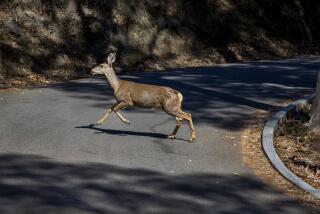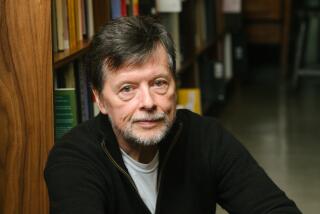Answering the Call of the Domesticated : COVENANT OF THE WILD: Why Animals Chose Domestication, <i> by Stephen Budiansky,</i> William Morrow & Co., $18; 172 pages
- Share via
Animal liberationists believe animals should enjoy the same freedom from human interference that people do. In their view, any use of animals to satisfy human needs is a crime against nature. Stephen Budiansky, author of the passionately and persuasively argued “Covenant of the Wild,” disagrees.
As he sees it, it is only natural for animals to use other animals. In this provocative first book, he fires a telling salvo at the advancing troops of the animal rights movement.
Budiansky says domestic animals chose us, historically, as much as we chose them. Basing his argument on new scientific data gathered from a variety of fields, Budiansky asserts that in the environmentally tumultuous times at the end of the last Ice Age, about 10,000 years ago, some animals began hanging around with humans in order to survive.
That strategy has turned out to be hugely successful, he says, pointing to the world’s current population of cats and dogs, sheep and goats, cattle and horses. The author’s main purpose in this well-documented essay is to trace the lines of scientific evidence that support his position, and to blast animal rights advocates for what he sees as their simple-minded romantic delusion that nature is, or should be, an Eden populated by majestic, independent beasts.
The spread of humans over the globe in the past 30,000 years or so has led to one particularly unfortunate effect, Budiansky says: Most men and women are now cut off from direct experience of nature. Their isolated state allows them to spin naive, idealistic fantasies about how nature ought to operate.
The author, himself a sheep farmer of 10 years’ experience as well as a senior writer for U. S. News & World Report, writes: “In a day when many of the animal rightists’ claims about the supposed cruelties of farming have attained the status of conventional wisdom (everyone seems to know about the suffering of veal calves and laying hens), few of us have the true wisdom or experience to place these claims in context.
Ignorant of the realities of nature, we imagine a paradise where all is well but for the cruelties man inflicts. . . . I don’t demand that those who would dictate to farmers how to treat their animals lie on a cold barn floor with their hand up a ewe’s uterus to save the lives of ewe and lamb; I don’t demand that they see a goose beheaded by an owl; I merely note that they haven’t.”
Budiansky’s rich firsthand experience with animals lends a ring of authenticity to his discussion of recent results of scientific inquiry into the co-evolution of humans and animals.
Summarizing data from archeologists, anthropologists and animal behaviorists, the author shows how modern domestic animals have been bred, by generations of humans who selected them for tameness, into permanently docile--and dependent--juveniles.
He observes that mature house cats kittenishly lift their tails when their owners are about to feed them, while wild cats outgrow this immature behavior early in their development. Adult horses and cows nuzzle humans in a begging gesture associated only with young animals among their wild brethren.
Even domestic animals’ adult physical development differs in its degree of maturity from that of their wild relatives, Budiansky says. For example, dogs’ jawbones than wolves’, and dogs’ skulls are larger and rounder in relation to their muzzles--all permanently puppyish physical traits.
Budiansky marshals impressive evidence that humankind’s current relationship with animals was inevitable in evolutionary terms. His views on the ivory trade (it should be permitted on a limited scale), laboratory animals (humane treatment of research animals need not be a contradiction in terms), and overpopulation (animals would prefer a swift bullet to slow starvation) will doubtless raise eyebrows. And the author is likely to offend some readers mightily with his broad-brush caricatures of animal rights advocates. But he has fired a shot that the animal rights community--and lawmakers--cannot fail to hear.
Next: Jonathan Kirsch reviews “Dawn Behind the Dawn” by Geoffrey Ashe (Henry Holt) .
More to Read
Sign up for our Book Club newsletter
Get the latest news, events and more from the Los Angeles Times Book Club, and help us get L.A. reading and talking.
You may occasionally receive promotional content from the Los Angeles Times.







